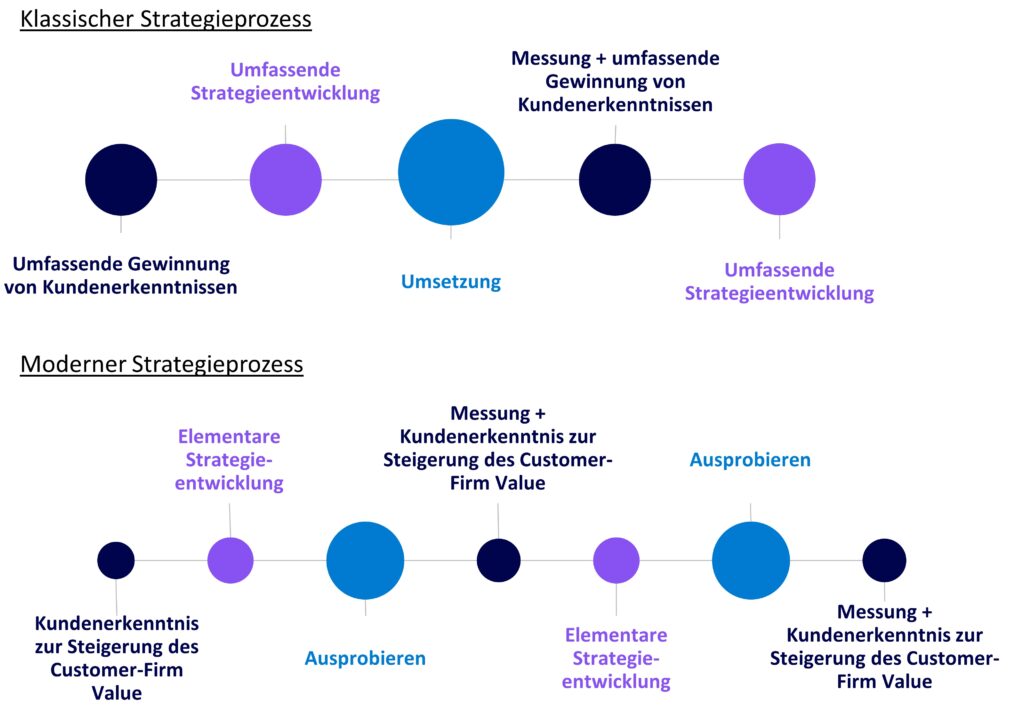The development of a strategy is characterized by a high degree of complexity. This results from the need for an integrated approach, as decisions do not only affect one part, but always the entire organization. This can result in a variety of unpredictable, uncertain behavioral possibilities. The number of possible goals, which can also be in conflict with each other, and the uncertainty about future developments combine to create a complex problem. In the context of digitization, it is proclaimed: “the strategic plan may indeed be dead”. The term “stractics” is established, which aims at planning that is closely linked to the instruments. In our view, this perspective on strategy is tiresome. It is also discussed whether the tension between strategies (high flexibility) and the structures inherent in an organization (lower flexibility) can be resolved.

In addition to the rigid planning of strategies, much more focus should be placed on the responsiveness of an organization. Anticipation and flexibility need to be thought of at the same time, if possible. Thus, the success of strategy development is expressed not only in the planning outcome, but also in an organization’s ability to respond due to change. Organizations that take a critical look at the medium and long-term planning of their future have more to gain from the success factor of time than their competitors. The question that was most pressing at the time of the Corona pandemic is: what is the exit strategy from the lock-down? How difficult it was for those responsible to develop a strategy and, above all, to coordinate it within the network (Europe/world) can be seen as evidence of how important strategy development fundamentally is in an organization. Above all, the trust that a communicated strategy conveys to employees should not be underestimated. We experience that strategy is more and more perceived as something disruptive. Shortened, the young Mintzberg is followed that the strategy results only from individual activities of an organization. Mintzberg later put this perspective into perspective, however, but the belief that speed is the key success factor and that change is increasingly dynamic calls into question the added value of strategic thinking and strategic planning. From our perspective, it’s about responsiveness, which builds on the quality of an organization’s learning processes. Learning is supported by the application of strategic planning, in that possible misjudgments can be systematically analyzed in retrospect. Therefore, trend analysis is of great importance as a preparation for strategic planning so that an organization can promote learning. As an example for the meanwhile idiosyncratic understanding regarding strategy, Bungay should be mentioned here, who published the following five beliefs regarding strategy:
- Strategy refers only to the distant future.
- Disruptors change their strategy all the time.
- There is no longer a competitive advantage.
- No strategy is needed – agility alone is enough.
- A digital strategy is absolutely necessary.
These five points more or less represent the current zeitgeist and are all wrong from our point of view. Strategy, as stated, refers primarily to learning and adapting an organization in the here and now, not just making plans for a distant future. It supports the necessary customer-centric transformation of an organization, which also has a medium- to long-term perspective. Most disruptors are built on the strategy formulated by Bruce Henderson: Price reduction and capacity increase. Even if it is called hypergrowth today, the idea is the same. Costs can be saved if the production volume is increased, and these can be passed on to customers in advance through price reductions. Thus, not that much change can be discerned among the “disruptors” in terms of strategy. Fundamentally, it is more difficult to maintain a competitive advantage, so organizations are moving to build multiple competitive advantages to compete. But that there is no longer any competitive advantage at all is an extreme view. A strategy provides a framework for decision making in an organization. Agile working is a competence, but it needs all the more a clear framework so that the individual teams can work together as purposefully as possible. The term “digital strategy” alone should be avoided from the perspective of customer orientation. It can promote silo thinking in the organization, and that is precisely what needs to be reduced as much as possible. A few years ago there was the term e-business strategy, now digital strategy. Sounds good – but strategy is simply strategy.
Definition strategy
Accordingly, strategy means orienting one’s thoughts, decisions and actions to the overriding or supreme goals or target prerequisites and not allowing oneself to be distracted by superficial urgencies, i.e. momentary advantages and disadvantages.
However, we agree that the effort and scope of strategic planning should be kept to a minimum in the meantime, and that the focus should be on trial and error, as well as on controlling the planning assumptions, rather than on developing comprehensive plans that can change quickly. Thus, what distinguishes the classic strategy process from the modern strategy process is the extent to which customer insights are gained (not in general! – only for strategy development) and the focus on trial and error instead of deterministic implementation. The view that strategy is to be understood as an induced, deterministic planning process was, however, already relativized by Mintzberg. Strategy development also faces the challenge of optimally combining centralization and autonomy. When decisions are shifted more to employees as part of customer orientation, new challenges arise. On the one hand, the effort for strategy development should be kept as low as possible, on the other hand, more employees should actually be integrated. This development means that strategy development as an organization’s competence is increasingly eroding, and as a result, while the supposed speed of decision-making is increasing, responsiveness based on a learning process can fall by the wayside. Moreover, only the time horizon of strategic planning is usually addressed or criticized, but strategic thinking refers not only to time but also to the development of decision options. Especially in times of increasing uncertainty, the development of options and their continuous review are elementary for the success of an organization.
Our offer in the field of customer orientation Consulting
Kundenorientierung ist in aller Munde. Dabei reicht es nicht aus, begeisternde bzw. möglichst einfache Erlebnisse zu definieren. Es gilt, die Anpassungsfähigkeit des Unternehmens an Veränderungen im Einkaufsverhalten der Kunden sicherzustellen. Als spezialisierte Beratung Kundenorientierung verfügen wir über Tools und Erfahrungen, Dich bei Deiner Transformation zur Verbesserung der Kundenorientierung erfolgreich zu unterstützen.
Das Buch zum Thema
The topic of strategy development is presented comprehensively in the book Customer Orientation starting on page 403. Practical examples are also provided and additional recommendations are made for the individual levels. A deeper understanding about strategy development is worthwhile.





